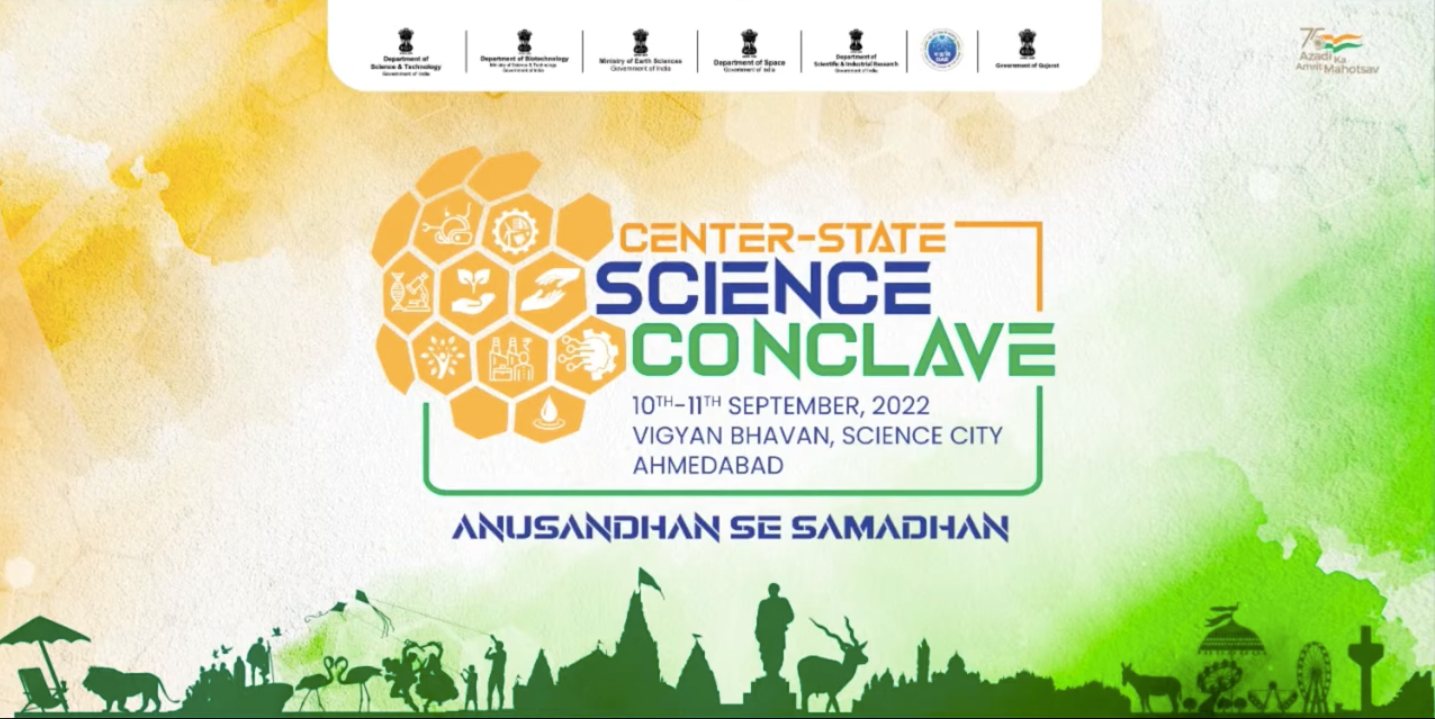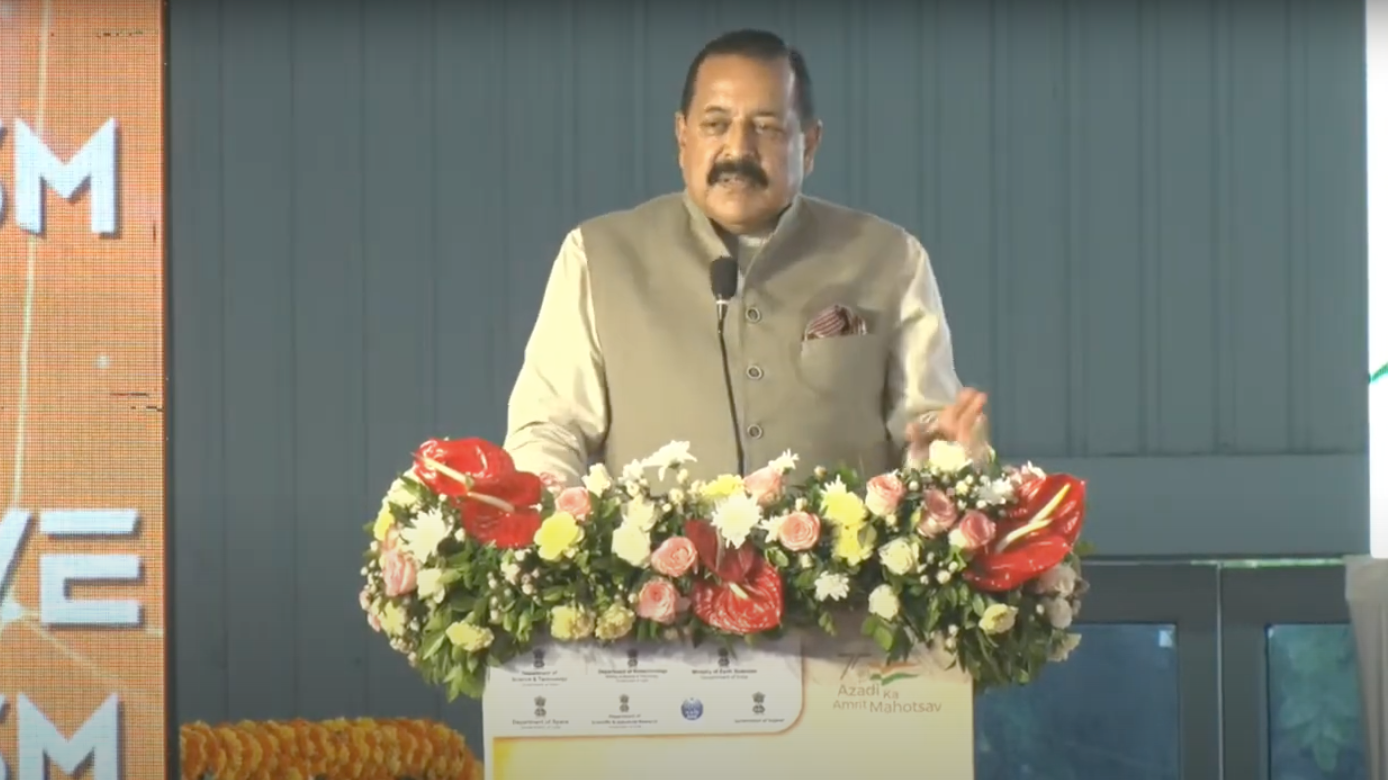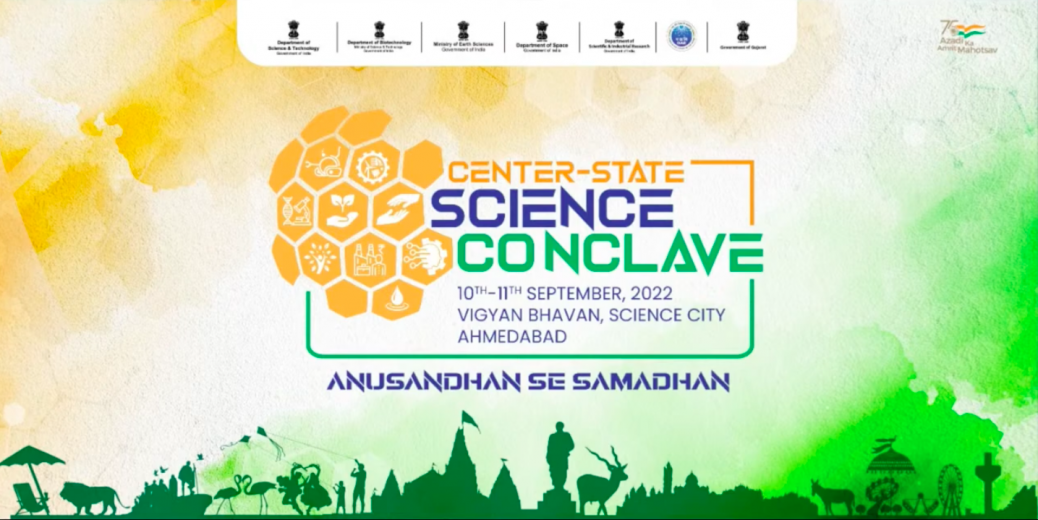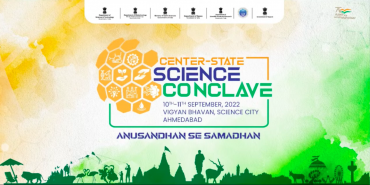
- A+
- A
- A-

The Centre–state Science Conclave, the first of its kind, was held at Science City in Ahmedabad, Gujarat, on 10th and 11th of September.
Image credits: Department of Science and Technology, Government of India.
“Science is like that energy in the development of 21st century India, which has the potential to accelerate the development of every region and every state. At a time when India is on the verge of leading the fourth industrial revolution, the role of India’s science and people associated with this field is very important. In such a situation, the responsibility of the policy-makers and those of us who are associated with governance and administration increases,” said Hon’ble Prime Minister Shri Narendra Modi, while virtually inaugurating the Centre–State Science and Technology Conclave held at Vigyan Bhavan, Science City, Ahmedabad, on 10th and 11th September 2022.
The Prime Minister stated that this conclave was an excellent representation of ‘sabka prayas’ (everyone’s efforts) and was crucial for achieving India’s goals for the next 25 years in the field of science and technology (S&T). He went on to point out that India’s rank in the Global Innovation Index has jumped from 81 to 46 in just 6 years, and that efforts towards making India a global center of research and innovation in this Amrit Kaal need to continue.

Speech by Hon’ble Prime Minister Shri Narendra Modi during the virtual inauguration of the Centre–State Science and Technology Conclave held at Vigyan Bhavan, Science City, Ahmedabad, on 10th and 11th September 2022.
Image credits: Department of Science and Technology, Government of India.
Indeed, in recent years, the Government of India has embarked upon a mission to strengthen its science, technology, and innovation (STI) ecosystem. During the conclave, Dr. Akhilesh Gupta, Secretary and Adviser at the Department of Science and Technology (DST), summarised the key challenges faced by the country today for strengthening its STI sector. According to him, “a major limitation is that the connect between institutions in states and those of the Centre is very poor and state-to-state collaborations are also very limited.” Through the session, it was also pointed out that there is huge variability in terms of quality, capacity, systems, and output among the STI ecosystems of different states, making information sharing a difficult task. Other challenges include the fact that only a few states have an STI policy, while many state S&T councils have not been proactive. This two-day event, the first of its kind, is meant to be a brainstorming session for the Centre and the states to take stock of these challenges and chalk out a collaborative pathway to achieving a sustainable and prosperous future.
After all, as the Hon’ble Prime Minister points out in his inaugural speech, a shift in the STI ecosystem is needed to fuel the progress of our nation in the next 25 years. He asserts that local challenges must beget local solutions, the government must collaborate more with the scientific community, states should maximize their utilization of national resources and institutes, and they should incentivize and support innovation in every possible way.
Post the inaugural address, state ministers from 12 states gave an overview of the recent achievements in their respective states and laid down their expectations from this brainstorming session. The panel was moderated by Dr. Jitendra Singh, the Hon’ble Minister of State (independent charge) for the Ministry of Science and Technology and the Ministry of Earth Sciences. Dr. Singh pointed out that the main objective of this conclave was to bring the representatives of the states and Centre together to identify the most appropriate technologies for each state and to deliberate on the best way of cooperatively implementing the necessary technologies.
This was followed by three plenary sessions that addressed India’s Vision 2047 in the S&T sector. These included a mapping of the priorities and technological needs of different states in setting up efficient STI clusters, and a discussion on how the private sector can invest and participate more in progressing national and state research and development (R&D), and thus, the overall economy. There were also talks on how sustainable start-ups can be boosted, how state–state interaction can be enhanced, how science education and communication can be improved, and more.
The day closed out with a recollection of the Centre–state collaborations that have occurred in the recent past. The different secretaries of the various departments under the Ministry of Science and Technology presented an overview of recent successful projects and ongoing projects conducted in coordination with several states. A few examples are the State Science and Technology program—an initiative by DST that aims to promote the nation’s STI ecosystem through Centre–State partnerships—and the Mission COVID Suraksha and Dare2eraDTB projects started by the Department of Biotechnology (DBT). Success stories of the Centre for Scientific and Industrial Research (CSIR) were also mentioned, including Mission Hydrogen, E-mobility, and the development of a diabetic-friendly and bacterial blight–resistant Samba Mahsuri rice crop. The Secretary of the Ministry of Earth Sciences spoke about the services that it provides to the different states, such as ocean-related services to coastal states and meteorological and geohazard services. The Department of Atomic Energy (DAE) highlighted its accomplishments in various sectors, including its recent success with afforestation using hydrogels. The secretary of the Department of Space and Chairman of ISRO spoke about various applications that are implemented by ISRO for different states, including providing inputs for crop intensification as part of the National Food Security Mission. These and other such cases showcased the great potential for S&T innovation when institutions of the Centre and states work together, making the case for the need for many more such collaborations to be realised.
The second day of the event comprised five more sessions with pointed discussions on various themes such as past and future technological interventions in agriculture, innovations to improve digital healthcare, potable water, clean energy for all, the One Health Mission to ensure holistic societal, agricultural, and environmental health, and the Deep Ocean Mission for exploring the sustainable use of ocean resources.

Dr. Jitendra Singh, the Hon’ble Minister of State (independent charge) for the Ministry of Science and Technology, speaking at the concluding session of the Conclave.
Image credits: Department of Science and Technology, Government of India.
The conclave concluded on a positive note, with Dr. Jitendra Singh assuring that measures will be put in place to improve coordination between the Centre and states and ensure a smooth flow of data among them. He highlighted ongoing work to develop a dashboard for this collaboration and noted that a nodal officer will be appointed in each state to oversee this development. The establishment of a Centre–State Science Council was also suggested, and it was decided that, going forward, this Conclave will be held annually in different states.
About the author
Neena Ratnakaran is a freelance science writer and editor.





